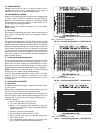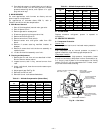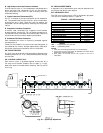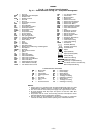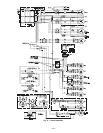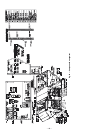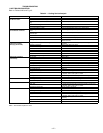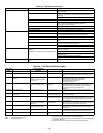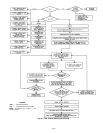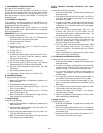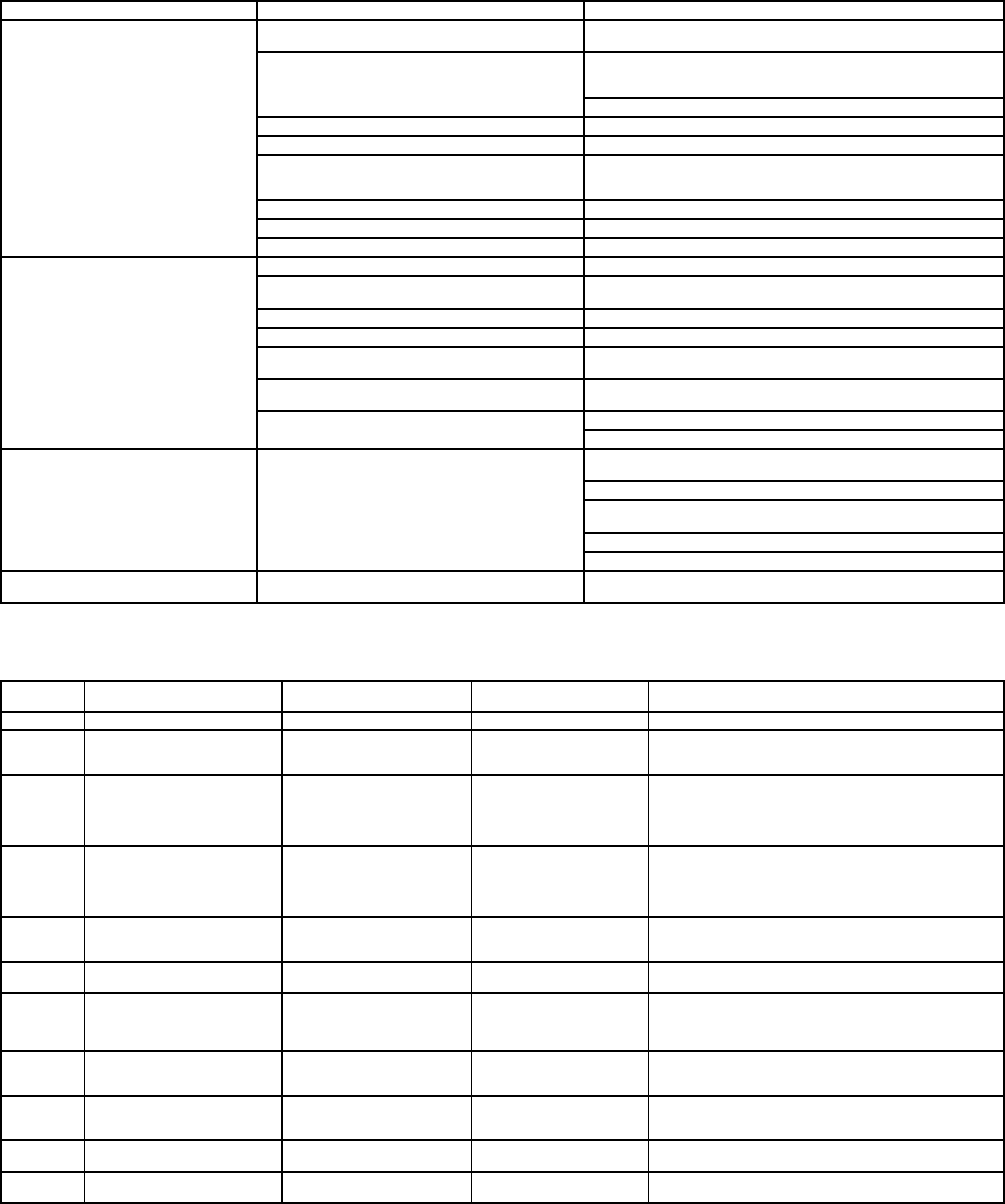
—48—
Table 35 — Heating Service Analysis
Table 36 — IGC Board LED Alarm Codes
LEGEND NOTES:
1. There is a 3-second pause between alarm code displays.
2. If more than one alarm code exists, all applicable alarm codes will be displayed
in numerical sequence.
3. Alarm codes on the IGC will be lost if power to the unit is interrupted.
PROBLEM CAUSE REMEDY
Burners Will Not Ignite. Misaligned spark electrodes. Check flame ignition and sensor electrode positioning.
Adjust as needed.
No gas at main burners. Check gas line for air; purge as necessary. After purging gas line of
air, allow gas to dissipate for at least 5 minutes before attempting to
relight unit.
Check gas valve.
Water in gas line. Drain water and install drip leg to trap water.
No power to furnace. Check power supply, fuses, wiring, and circuit breaker.
No 24 v power supply to control circuit. Check transformer. Transformers with internal overcurrent protection
require a cool-down period before resetting. Check 24-v
circuit breaker; reset if necessary.
Miswired or loose connections. Check all wiring and wire nut connections.
Burned-out heat anticipator in thermostat. Replace thermostat.
Broken thermostat wires. Run continuity check. Replace wires if necessary.
Inadequate Heating. Dirty air filter. Clean or replace filter as necessary.
Gas input to unit too low. Check gas pressure at manifold. Clock gas meter for input. If too low,
increase manifold pressure or replace with correct orifices.
Unit undersized for application. Replace with proper unit or add additional unit.
Restricted airflow. Clean filter, replace filter, or remove any restrictions.
Blower speed too low. Install alternate motor, if applicable, or adjust pulley to increase fan
speed.
Limit switch cycles main burners. Check rotation of blower, thermostat heat anticipator settings, and
temperature rise of unit. Adjust as needed.
Too much outdoor air. Adjust minimum position.
Check economizer operation.
Poor Flame Characteristics. Incomplete combustion (lack of combustion air)
results in:
Aldehyde odors, CO, sooting flame, or floating flame.
Check all screws around flue outlets and burner compartment.
Tighten as necessary.
Cracked heat exchanger.
Overfired unit — reduce input, change orifices, or adjust gas line or
manifold pressure.
Check vent for restriction. Clean as necessary.
Check orifice to burner alignment.
Burners Will Not Turn Off. Unit is locked into Heating mode for a one minute min-
imum.
Wait until mandatory one minute time period has elapsed or power to
unit.
LED FLASH
CODE
DESCRIPTION
ACTION TAKEN BY
CONTROL
RESET METHOD PROBABLE CAUSE
On Normal Operation — — —
Off Hardware Failure No gas heating. — Loss of power to the IGC. Check 5 amp fuse on IGC, power
to unit, 24V circuit breaker, transformer, and wiring to the
IGC.
1 Flash Indoor Fan On/Off Delay
Modified
5 seconds subtracted from On
delay.
5 seconds added to Off delay
(3 min max).
Power reset. High temperature limit switch opens during heat exchanger
warm-up period before fan-on delay expires.
High temperature limit switch opens within
10 minutes of heat call (W) Off.
See Limit Switch Fault.
2 Flashes Limit Switch Fault Gas valve and igniter Off.
Indoor fan and inducer On.
Limit switch closed, or heat
call (W) Off.
High temperature limit switch is open. Check the operation
of the indoor (evaporator) fan motor. Ensure that the sup-
ply-air temperature rise is within the range on the unit
nameplate. Check wiring and limit switch
operation.
3 Flashes Flame Sense Fault Indoor fan and inducer On. Flame sense normal.
Power reset for LED reset.
The IGC sensed a flame when the gas valve should be
closed. Check wiring, flame sensor, and gas valve opera-
tion.
4 Flashes Four Consecutive Limit
Switch Fault
No gas heating. Heat call (W) Off.
Power reset for LED reset.
4 consecutive limit switch faults within a single call for heat.
See Limit Switch Fault.
5 Flashes Ignition Fault No gas heating. Heat call (W) Off.
Power reset for LED reset.
Unit unsuccessfully attempted ignition for 15 minutes. Check
igniter and flame sensor electrode spacing, gaps, etc. Check
flame sense and igniter wiring. Check gas valve operation
and gas supply.
6 Flashes Induced Draft Motor Fault If heat off: no gas heating.
If heat on: gas valve Off and
inducer On.
Inducer sense normal, or
heat call (W) Off.
Inducer sense On when heat call Off, or inducer sense Off
when heat call On. Check wiring, voltage, and operation of
IGC motor. Check speed sensor wiring to IGC.
7 Flashes Rollout Switch Lockout Gas valve and igniter Off.
Indoor fan and inducer On.
Power reset. Rollout switch has opened. Check gas valve operation.
Check induced-draft blower wheel is properly secured to
motor shaft.
8 Flashes Internal Control Lockout No gas heating. Power reset. IGC has sensed internal hardware or software error. If fault
is not cleared by resetting 24 v power, replace the IGC.
9 Flashes Temporary Software Lockout No gas heating. 1 hour auto reset, or power
reset.
Electrical interference is disrupting the IGC software.
IGC — Integrated Gas Unit Control
LED — Light-Emitting Diode



